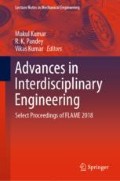Abstract
The rising population is closely related to the improvement and importance of transportation. Moreover, the rapid increasing Indian economy also entangles manufactures in enhancing the performance of internal combustion engine. The increasing number of vehicles with speedy advancement of technology is leading world to have around 2 billion vehicles by 2020. The exhaust emission from these vehicles is also contributing to myriad problems. The exhaust contains harmful gases like carbon monoxide (CO), hydrocarbon (HC), sulfur oxides (SOx), nitrogen oxides (NOx), and particulate matters PM2.5 and PM10. Keeping in mind the Environment Act, 1986 of India and The Air (prevention and control of pollution) Act, 1981 of India, this paper is prepared for the betterment of our environment, and related to this is an idea to introduce an exhaust system in addition to three-way catalytic convertor for reducing the gases such as sulfur dioxide (SO2), carbon dioxide (CO2), and particulate matter emitted from vehicles comprising a heat absorbing freezer gel pack chamber which would be immediately preceded by the catalytic converter. A chamber containing graphite electrodes in aqueous electrolyte water to absorb sulfur dioxide (SO2) and a chamber for absorbing carbon dioxides (CO2) in alkali solution and for trapping particulate emitted in exhaust by catalytic convertor filter layer is being used.
Access this chapter
Tax calculation will be finalised at checkout
Purchases are for personal use only
References
Industries MH (2004) Environmental friendly diesel engine. UEC Eco-Engine 41(1):2–4
Elliott MA, Nebel GJ, Rounds FG (1955) The composition of exhaust gases from diesel, gasoline and propane powered motor coaches. J Air Pollut Control Assoc 5(2):103–108
Sharaf J (2013) Exhaust emissions and its control technology for an internal combustion engine. Int J Eng Res Appl 3(4):947–960. www.ijera.com
Saini B, Verma R, Himanshu SK, Gupta S (2013) Analysis of exhaust emissions from gasoline powered vehicles in a sub-urban Indian town. Environment 2(1):37–42
Rouphail NM, Frey HC, Colyar JD, Unal A (2000) Vehicle emissions and traffic measures: exploratory analysis of field observations at signalized arterials. In: TRB annual meeting, Nov 2000
Tong HY, Hung WT, Cheung CS (2000) On-road motor vehicle emissions and fuel consumption in urban driving conditions. J Air Waste Manag Assoc 50(4):543–554
Shiva Nagendra S, Khare M (2003) Principal component analysis of urban traffic characteristics and meteorological data. Transp Res Part D Transp Environ 8(4):285–297
Leman AM, Rahman F, Jajuli A, Zakaria S, Feriyanto D (2017) Emission treatment towards cold start and back pressure in internal combustion engine against performance of catalytic converter : a review. In: 9th International UNIMAS STEM Engineering Conference (ENCON 2016), 02021, p 7
Pesansky JD, Majiros NA, Sorensen CM, Thomas DL (2009) The effect of three-way catalyst selection on component pressure drop and system performance
Marsh P, Acke F, Konieczny R, Brück R (2001) Application guideline to define a catalyst layout for maximum catalytic efficiency. Society of Automotive Engineers
Amirnordin SH, Seri SM, Salim WSW, Rahman HA, Hasnan K (2011) Pressure drop analysis of square and hexagonal cells and its effects on the performance of catalytic converters. Int J Environ Sci Dev 2(3):239–247
Korin E, Reshef R, Tshernichovesky D, Sher E (1999) Reducing cold-start emission from internal combustion engines by means of a catalytic converter embedded in a phase-change material. Proc Inst Mech Eng Part D J Automob Eng 213(6):575–583
Soumelldis MI, Stobart RK, Jackson RA (2007) A chemically informed, control-oriented model of a three-way catalytic converter. Proc Inst Mech Eng Part D J Automob Eng 221(9):1169–1182
Subramani T (2012) Study of air pollution due to vehicle emission in tourism centre. Int J Eng Res Appl 2(3):1753–1763
Farrauto RJ, Heck RM (1999) Catalytic converters: state of the art and perspectives. Catal Today 51(3–4):351–360
Greenstone M, Hanna R (2014) Environmental regulations, air and water pollution, and infant mortality in India
Karkanis AN, Botsaris PN, Sparis PD (2004) Emission reduction during cold start via catalyst surface control. Proc Inst Mech Eng Part D J Automob Eng 218(11):1333–1340
Zhang J, Song C, Zhang J, Baker R, Zhang L (2013) Understanding the effects of backpressure on PEM fuel cell reactions and performance. J Electroanal Chem 688:130–136
Author information
Authors and Affiliations
Corresponding author
Editor information
Editors and Affiliations
Rights and permissions
Copyright information
© 2019 Springer Nature Singapore Pte Ltd.
About this paper
Cite this paper
Pal, P., Sharma, P., Sharma, A., Bhandwal, M. (2019). A Novel System Based on the Principle of Electrochemical Treatment to Reduce Exhaust Emission from Gasoline-Operated Engine. In: Kumar, M., Pandey, R., Kumar, V. (eds) Advances in Interdisciplinary Engineering . Lecture Notes in Mechanical Engineering. Springer, Singapore. https://doi.org/10.1007/978-981-13-6577-5_20
Download citation
DOI: https://doi.org/10.1007/978-981-13-6577-5_20
Published:
Publisher Name: Springer, Singapore
Print ISBN: 978-981-13-6576-8
Online ISBN: 978-981-13-6577-5
eBook Packages: EngineeringEngineering (R0)

